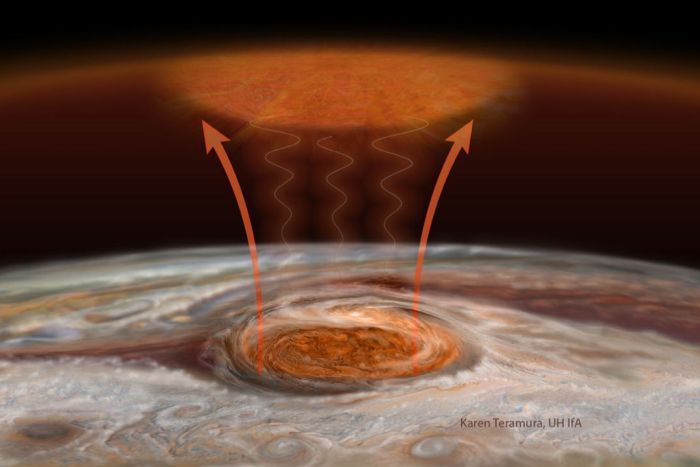A new study of Jupiter, published today in Nature, has found an unusual spike in temperatures above the Great Red Spot.
While generally, the upper atmosphere is around 500 degrees C, measurements taken using the NASA Infrared Telescope Facility in Hawaii have found temperatures soar to around 1300 degrees above the Great Red Spot.
"The first thing we thought was `oh great, another thing we can`t explain`," said co-author Dr James O`Donoghue, from the Center for Space Physics at Boston University.
But, after a "process of elimination", Dr O`Donoghue and colleagues concluded the upper atmosphere above the Great Red Spot was being heated from below, by turbulence.
The Great Red Spot is a storm two to three times the size of Earth with winds that tear around at 480 kilometres per hour in an anti-clockwise direction. The surrounding atmosphere, by contrast, moves in the opposite direction.
"If you`re stirring a cup of tea to the right continuously so it`s got its own flow, but then you stir it the other way, you get a lot of sloshing around, and that`s basically what the Great Red Spot is doing in the atmosphere," Dr O`Donoghue said.
He and colleagues said shear created between the storm winds and the atmosphere would create huge amounts of turbulence in the form of gravity waves and acoustic, or sound waves, which vibrate molecules in the air and heat them up.
Atmospheric heat explained
Turbulence may also help explain a long-standing mystery, the researchers said.
Even at 500 degrees C, Jupiter`s upper atmosphere (other than that above the Great Red Spot) is hotter than it should be, and scientists have long wondered why.
While the Sun heats the Earth`s upper atmosphere to greater than 2,000 degrees C, Jupiter is too far away for it to be affected in this way.
At five times further away from the Sun than Earth and receiving 3 per cent of the energy, the gas giant`s upper atmosphere should be well below zero degrees.
One explanation for this discrepancy could be heat from the auroras that flicker around Jupiter`s poles, which are heated by enormous streams of charged particles crashing into the atmosphere. But the heat from the auroras does not spread to the rest of the planet.
The observed heating above the Great Red Spot suggests turbulence could also be responsible for heating the rest of the atmosphere as well, said Dr O`Donoghue and colleagues.
They said the rest of Jupiter is likely to be affected by turbulence between its upper and lower atmospheres — albeit to a lesser degree.
"There are winds that are going eastward and westward against each other all over the planet, so we think that maybe there`s turbulence there too," Dr O`Donoghue said.
"It`s not as easy to see it because it`s spread thinly and in smaller amounts all over the planet, but as we get more improvements in technology, we might be able to zoom in on the exact sources of these things."
NASA`s Juno spacecraft, which arrived in orbit around Jupiter on July 4, may also help scientists piece together the puzzle of Jupiter`s atmosphere by providing data on what is happening beneath the clouds.
More about:
















































